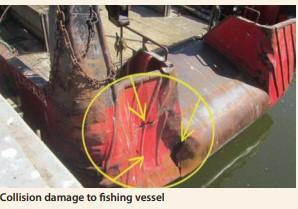202326 - Collision – what collision?
In daylight and good visibility, a 25 metre steel fishing vessel was engaged in fishing about 20nm offshore. With fishing gear set, it was making way at about two to three knots when the Master noticed a small cargo vessel approaching at about 13 knots and realised that a close quarters situation was developing.
As edited from TAIIB (Latvia) report 1-2020
With the cargo vessel about 2nm away, the Master of the fishing vessel attempted to call the cargo vessel, but did not receive any answer. Soon, with the distance between the vessels decreasing and no response from the cargo vessel, the fishing Master realised he must take avoiding action. He put the helm hard to port and increased engine power to full ahead, even though this put the fishing gear at risk of damage. Nonetheless, the cargo vessel’s bow hit the aft superstructure of the fishing vessel, causing damage across an area of 1.5m2. The cargo vessel did not respond to further calls from the fishing vessel and kept its course and speed as if nothing had happened. The subsequent investigation by authorities found the following entry in the cargo vessel’s logbook; ‘small collision with fv’

Lessons learned
- Never leave the scene of a collision until confirmation has been received from all concerned that everything is under control and pertinent information from both vessels has been exchanged.
- While not specified in the official report, it can be assumed that the lone watch keeper on the cargo vessel was not keeping an effective lookout for other vessels. The course and speed of the cargo vessel never changed and the watch keeper never responded to the VHF calls from the fishing vessel. A power driven vessel underway must keep clear of a vessel engaged in fishing.
